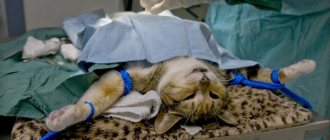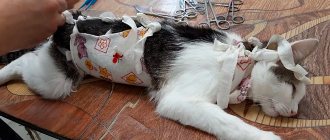7929Pavel
1
In cases of serious illness, all pets require medical attention. And often it has to be provided at home. If it is necessary to give an animal an IV or remove fluid from the bladder, many owners ask questions about how to place and remove a catheter from a cat.
Thanks to this device, it is possible to avoid constant injections. The catheter allows you to give your pet a drip or injection at any time necessary.
© shutterstock
And in the postoperative period or in case of diseases of the urinary system, this device allows you to empty the animal’s bladder of excess fluid completely painlessly.
When and why is intermittent catheterization recommended?
Intermittent catheterization is an effective and safe method of urinary diversion that offers patients independence and significantly improves quality of life.
In recent years, periodic catheterization has become the preferred method for the management of patients with neurogenic bladder dysfunction, paraplegia, diseases such as spina bifida or multiple sclerosis. The choice of the method of intermittent catheterization is made only after this technique is recommended by the doctor in each specific case. Catheterization is accomplished by emptying the bladder at regular intervals using disposable catheters.
Urinary catheter
Urinary catheter
is a flexible tube-like device used to empty the bladder. Emptying occurs either directly into the toilet, as with natural urination, or into a special urinal bag. Most often they are inserted through the urethra, a thin tube that leads into the bladder, or if indicated, a catheter is inserted in the suprapubic area through a small hole in the lower abdomen.
There are two main types of urinary catheters:
- Indwelling Foley catheters, which are inserted through the urethra into the bladder and allow urine to pass unimpeded into a urine bag. This type of catheter remains in the urethra and bladder for a long time and is held in place by a special balloon that is inflated after insertion into the bladder;
- disposable catheters used for self-catheterization (Nelaton, Thiemann), they are temporarily inserted into the bladder through the urethra and removed after emptying the bladder.
An indwelling urinary catheter
is connected to a urine bag using a tube, this tube drains urine through the tube into a bag, and the bag is then emptied using a drain valve on the bag. There is no need to change the permanent catheter. The urine bag can be attached to the leg using straps or hung near the bed with the help of a special hook-hanger during sleep.
Disposable urinary catheter
Suitable for patients who do not need to use a catheter constantly or who do not want or have the ability to wear a urine bag. A disposable catheter is inserted into the urethra only at the moment of voiding to empty the bladder, and then removed from the urethra after emptying. This procedure can be performed several times a day. The frequency depends on the reason you need to use this method or how much urine needs to be removed from the bladder.
For frequent use, choose a quality urinary catheter that is pre-lubricated to avoid the risk of damaging the urethra.
A urinary catheter should only be used as directed by a physician. In cases where there is difficulty urinating naturally, or there is residual urine in the bladder and complete emptying does not occur. It is also used in the pre- or post-operative period.
A urinary catheter is used:
- to make urination easier if there is an obstruction in the urethra (scars, enlarged prostate, tumors);
- to help empty the bladder in cases of weak muscles or nerve damage that prevent you from emptying your bladder on your own;
- during labor if you have an epidural;
- after different types of surgery to drain the bladder, before after or during long-term surgery;
- to deliver drugs directly to the bladder, for example during chemotherapy for bladder cancer.
You will need to discuss which catheter is right for you with your doctor.
Some patients are more suited to an indwelling catheter if there is a need to ensure a continuous flow of urine, while others are more suited to using a disposable urinary catheter. The former is convenient because it avoids repeated insertions, but indwelling catheters are more likely to cause problems such as infections. Inserting some types of catheters can be awkward or even uncomfortable, so an anesthetic gel may be used to reduce pain. However, you can purchase ready-to-use Coloplast urinary catheters
They are created specifically taking into account the wishes of the patients using them, and at the moment they are the most convenient, comfortable and safe to use, because are already coated with a lubricant for easy insertion and removal of the catheter, and also do not contain latex, thereby not causing allergies and irritation.
The main problems caused by urinary catheters are infections of the urethra, bladder, or, less commonly, kidneys. These types of infections are known as urinary tract infections (UTIs) and usually require treatment with antibiotics. There is a potential risk of getting a UTI with either an indwelling catheter or a disposable catheter if hygiene is not followed during insertion. However, the longer the catheter is used, the higher the risk of infection. This is why it is important that catheters are inserted correctly, maintained properly, and used only for as long as needed.
Catheters can also sometimes cause other problems, such as bladder cramps (similar to stomach cramps), leaks, blockages, and damage to the urethra. If you feel any discomfort, discomfort, burning in the urethra, bladder or kidneys, contact your doctor immediately.
Sometimes urine may leak around the catheter or, conversely, not flow out. This may be caused by:
- the catheter has a kink
- Incorrect catheter size
- bladder spasm
- there is a blockage in the catheter
- wrong balloon size
- urethral infection
Be sure to consult with your doctor which catheter is best for you to use, if necessary.
How to insert a disposable urinary catheter (Nelaton, Tiemann urological catheter)
| Women | Men | |||
| Clean the injection area before the procedure | ||||
| 1. Spread the labia with the fingers of your non-dominant hand. 2. Using disinfectants (chlorhexidine cotton swab or sterile wipes) and your dominant hand, clean the labia and urethral meatus from the clitoris to the anus, and from the outside of the labia to the inner folds of the lips and urethral meatus. Use a new cotton swab or tissue each time you cleanse. | 1. Grasp the penis and hold it at a right angle to the body throughout the procedure with your non-dominant hand. 2 Using disinfectants (chlorhexidine cotton swab or sterile wipes) and your dominant hand, clean the urethral meatus in a circular motion, moving outward from the meatus. Use a new cotton swab or tissue each time you cleanse. | |||
| Take the catheter as follows | ||||
| 1. Hold the catheter with your sterile dominant hand 7.5 to 10 cm below the tip of the catheter. 2. Make a movement, apply slight pressure (as when urinating) to expose the urethral meatus. 3. Advance the catheter 5 to 7.5 cm until urine flows from the catheter, then advance another 5 cm. | 1. Holding the catheter close to the tip will help control and manipulate the catheter during insertion. 2. Keeping your penis perpendicular to your body, pull slightly. 3. Make an effort, press slightly (as when urinating) and slowly insert the catheter through the urethral meatus. 4. Advance the catheter 17 to 22.5 cm or until urine flows from the catheter. | |||
| Attention! | ||||
| If urine does not appear, the catheter may be in the vagina. Advance the catheter deeper if you do not experience pain. If pain occurs, consult a doctor | If the catheter does not advance, do not use force. Take a deep breath and try again. If the catheter still does not advance, stop the procedure and notify your doctor. There may be an enlarged prostate or urethral obstruction. | |||
In our online store you can purchase catheters from Coloplast
. Leading manufacturer of self-catheterization catheters, pre-lubricated and ready for use. Effective, safe and hypoallergenic.
Article published: 08/02/2021
How is intermittent catheterization performed in children?
Children with neurogenic bladder dysfunction can be catheterized by parents or a healthcare professional, always using aseptic technique. Parents should ask their doctor or health care professional to explain and demonstrate the correct catheterization procedure. Only by thoroughly preparing can you be sure that you are performing the catheterization procedure correctly.
For infants and small children, the following sizes are typically used: 2.0–2.7 mm (Ch06–Ch08).
Caring for the animal after catheterization
After completing the manipulations, the veterinarian will examine the condition of the tube. If kinks or dents are detected in the system, there is a possibility of injury. The dye used in the procedure is excreted from the body by the kidneys. Antispasmodics are prescribed to relieve unpleasant symptoms.
At home, care involves observation. Before increasing the daily amount of fluid consumed, you should consult a veterinarian, because... the animal may have problems urinating. A burning sensation in the urethra occurs when urine is released the first few times. If your pet's discomfort lasts longer, it is a sign of infection. Post-obstructive diuresis is a common complication requiring immediate hospitalization.
To diagnose the causes of discomfort and examine your pet, you need to call a doctor at home.
All information posted on the site is provided in accordance with the User Agreement and is not a direct instruction to action. We strongly recommend that before using any product, you must obtain a face-to-face consultation at an accredited veterinary clinic.
Types of complications
After vaccination, your pet often experiences temporary complications. They can be expressed as follows:
- an allergic reaction to the injection . It can be expressed, in particular, in the form of swelling, redness, and skin rashes. In such cases, an antihistamine is additionally administered. In extremely severe cases, anaphylactic shock may occur.
- may appear under the skin at the withers in the form of a small bump. The reason may be unprofessional administration of the vaccine or the individual characteristics of the animal’s body.
- Reduced immunity during the quarantine period increases the likelihood of other diseases or the appearance of worms.
- Sometimes vaccination can contribute to the manifestations of kidney failure. This is due to the fact that the vaccine is made from cat kidney cells. Once in the body, it can cause the formation of antibodies that act on this organ. The main cause of this complication is too frequent vaccination.
When a pet suffers during vaccination, a loving owner is obliged to do everything possible to support the animal and alleviate its suffering.
If there is a lump
One of the possible complications after vaccination is the formation of a lump at the injection site. First of all, it is important to determine the cause of what happened. If you contact a specialist, he will conduct a thorough analysis, determine the diagnosis and offer appropriate treatment.
Typically, the following means can be used for this:
- taking medications;
- use of compresses;
- in rare cases, surgery may be required.
Usually this problem is solved in no more than a week.
Vaccination options for cats
Vaccine for cats
Responsible cat owners expect to travel with their pets by car, plane, train, participate in expert exhibitions, and export their pets abroad. In this case, they visit the clinic.
The veterinarian conducts a clinical examination, asks the owner when the pet was dewormed, at what time the fleas were expelled and what medications were used. They check the age of the cat, whether it has been vaccinated before and what biological products were used. They make a note in the passport, certify it with a seal, put down the date and name of the veterinarian who performed the vaccination.
Amateurs who do not intend to exhibit, try to save money, purchase a biological product and inject it themselves. In both the first and second cases, there is no absolute guarantee that swelling will not occur after vaccination.
But if in a professional veterinary institution the cat owner can count on help, then when he pierces the vaccine himself, he solves the problem on his own or for an additional fee.











